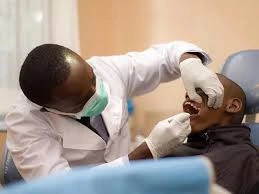Author's details
- Dr. Khashau Eleburuike
- MBBS (Ilorin) MSc. Global Health Karolinska Institute.
- Resident doctor in family medicine in Northern Sweden.
Reviewer's details
- : Dr Adeyemi, Moshood Folorunsho.
- BDS, FMCDS
- Maxillofacial surgeon University of Ilorin Teaching Hospital/University of Ilorin

- Date Published: 2025-03-19
- Date Updated: 2025-03-19
Oral Cancer Prevention in Sub-Saharan Africa
Oral cancer, a type of cancer that affects the mouth, tongue, lips, and throat, is a significant public health issue worldwide. In sub-Saharan Africa, oral cancer cases are increasing due to factors such as tobacco use, alcohol consumption, poor oral hygiene, and infections like human papillomavirus (HPV). Early detection and prevention can greatly improve outcomes.
- Avoid Tobacco Use: Tobacco in any form—cigarettes, chewing tobacco, or snuff—increases the risk of developing oral cancer. Quitting smoking or never starting is one of the best ways to reduce this risk.
- Limit Alcohol Consumption: Excessive alcohol use is another major risk factor for oral cancer. Reducing alcohol intake, especially when combined with tobacco use, can help lower the risk.
- Practice Good Oral Hygiene: Maintaining clean teeth and gums through regular brushing, flossing, and dental check-ups can help prevent oral infections and other issues that may increase the risk of cancer.
- Eat a Healthy Diet: A diet rich in fruits, vegetables, and whole grains can strengthen the immune system and protect the body against many cancers, including oral cancer.
- Vaccination and Safe Practices: HPV infection is linked to some types of oral cancer. Vaccination against HPV, safe sexual practices, and regular medical check-ups can help reduce this risk.
- Sun Protection for Lips: Protect your lips from harmful UV rays by using lip balms with sunscreen, especially if you work outdoors.
Oral cancer is preventable, and taking proactive steps can significantly reduce the risk. By avoiding tobacco and alcohol, practicing good oral hygiene, maintaining a healthy diet, and seeking regular medical and dental care, individuals in sub-Saharan Africa can protect themselves against oral cancer. Early detection is key, so it’s essential to seek medical advice if any unusual symptoms like persistent mouth sores, lumps, or pain are noticed.
- World Health Organization. Oral Health. Available at: https://www.who.int/news-room/fact-sheets/detail/oral-health Accessed Nov. 26 2024
- Murray JJ, Nunn JH, Steele JG, editors. The prevention of oral disease. Oxford University Press; 2003 Jun 5.
- Van der Waal I. Oral potentially malignant disorders: is malignant transformation predictable and preventable?. Medicina oral, patología oral y cirugía bucal. 2014 Jul;19(4):e386.
